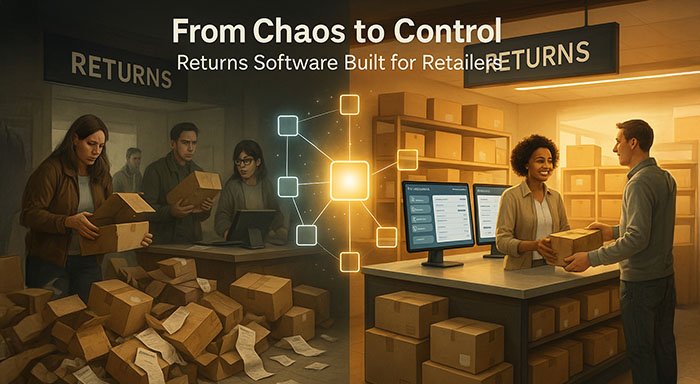For numerous retailers, returns often feel like a consistent logistical nightmare that never gets completely streamlined. You have disorganized and messed up systems where return data is siloed and spread across various places. You also have unclear policies that cause confusion among your staff members and customers who just need to know when their item will be replaced, or their money will be returned.
In the absence of streamlined processes and right technologies, return can quickly turn into a logistical nightmare causing great bottlenecks in operations, losses in revenue, and lasting reputational damage. You must have seen a lot of retailers lose customers on the fly primarily over return experiences, which is quite a fixable problem. Just by integrating better tools with better features and adopting clearer communication, retailers can enhance return experiences and improve their profits.
Here is the best part: Integrating the returns software for retailers, what did feel like complete chaos can quickly turn into a customer-convenient and simplified system that boosts your brand presence instead of damaging it. The transformation can be dramatic when you move from manual, error-prone processes to automated workflows that work smoothly for everyone involved.
In 2025, we have advanced return platforms that is specialized to navigate return challenges, integrating features like smarter automation, real-time visibility across various channels, and user-convenient portals that please customers. In this article, let us see how the perfect return software revolutionizes your workflows into effective processes that improve both your customer relationships and business processes.
The Underlying Cost of Improper Returns Processes
A lot of retailers ignore the underlying losses that ineffective return management causes. The straightforward expenses such as restocking fees and shipping are just the surface level losses - the real depth of damage are identified in areas that are difficult to monitor but costlier in the longer run.
Returns typically cost retailers anywhere from 10 to 20 percent of their total revenue when you factor in all the direct and indirect expenses. Manual management of tasks generates great labor expenses. With manual tasks, you are asking your team to spend hours processing returns that can be automated. Not only that, but there are also unavoidable human errors that occur when people get involved in routine tasks under time constraints.
Ineffective return experiences can lead to poor reviews that can leave a bad impression on your potential customers when they research your business. You will have to deal with lost customers who leave your brand forever after a poor return experience. Thus, you will have to face lasting impacts such as reduced trust in your brand and loss of customer trust, which takes months and even years to re-build.
The increasing cost of return inefficiency:
- Direct processing costs that impact profit margins.
- Customer service time that gets spent in dealing with return queries and complaints.
- Loss of potential customers caused by negative online reviews and bad word-of-mouth perceptions.
- Discrepancies in inventory that occur due to manual error tracking.
- Competitive edge to competitors who ensure comprehensively smooth return processes.
The brands that consider returns to be an afterthought or non-priority task often fall behind other brands. Brands who see returns as a strategic opportunity ensure greater operational efficiency and customer loyalty.
How Returns Software Can Create Efficiency and Order?
An effective returns software brings a lot of order to chaos by streamlining all return-related data and automating routine tasks that eat your team’s energy and time. Instead of managing numerous systems, email chains, and spreadsheets, everything gets streamlined at a centralized place, offering clear visibility to all stakeholders.
Self-service customer portals minimize the number of support tickets related to return. Such portals can allow customers to initiate return, monitor status, and print labels without having to contact your support team. This can mitigate customer satisfaction while also allowing your support staff to manage complex issues that actually need more human intervention.
Incorporated workflows enhance accuracy of warehouse and speed by routing returned items automatically through streamlined restocking processes and inspection as per your business rules. Real-time status updates reduce the constant stream of "Where's my return?" inquiries that bog down customer service teams.
When everything is automated and integrated properly, you get fewer processing errors, faster restocking of sellable items, and significantly fewer operational headaches that used to consume your team's attention.
Features That Matter Most to Retailers
Modern retailers need returns software that handles the complexity of multiple sales channels, high return volumes, and increasingly demanding customer expectations. The most important features are the ones that solve real operational problems rather than just looking impressive in demos.
Omnichannel support is essential because customers expect to be able to return online purchases in-store and vice versa. Your software should handle both scenarios seamlessly without creating confusion or requiring duplicate data entry.
Branded return portals maintain your customer experience and brand consistency rather than sending customers to generic white-label interfaces that feel disconnected from your brand. QR code return options eliminate the friction of printing labels while supporting mobile-first customer behavior.
Return reason tracking provides the business intelligence you need to identify patterns, improve product descriptions, and make better purchasing decisions based on why customers are actually returning items. This data can be invaluable for reducing future return rates.
Integration capabilities with your existing ecommerce platform, point-of-sale system, and third-party logistics providers ensure that return information flows seamlessly through your entire operation without manual data entry or synchronization issues.
Real Results: What Retailers Gain From Using the Right Software
Retailers who invest in proper returns management software see measurable improvements across multiple areas of their business, from operational efficiency to customer satisfaction and long-term profitability.
Processing time dramatically drops when brands switch from manual tasks to automated tasks and flow of data is smooth between various systems. Labor expenses get substantially reduced as your team starts to spend more time on strategic tasks instead of engaging with routine and unproductive administrative workload.
Overall customer satisfaction also improves when return processes become hassle-free and quick. Not only does it lead to word-of-mouth recommendations but also repeat purchases. Centralized data and return insights aid you in recognizing issues in product quality, enhance descriptions, and make more intelligent inventory decisions.
Exchange-first workflows aid in preserving revenue as it makes customers to consider items swap rather than going for full refunds. It allows you to keep your money within your business while also solving the customer problem at the same time.
All of these enhancements work together to ensure an authentic competitive edge in the vying ecommerce landscape and retail markets where better customer experience ensures lasting success.
Conclusion
Returns do not have to be a consistent source of frustration and chaos for your customers and team. With the best software platforms, returns can actually turn out to be an asset. They drive operational efficiency, customer loyalty, and lasting profitability instead of just being a costly asset you are trying to reduce.
The best return management tools of today are designed especially for retail realities: diversified sales channels, seasonal spikes, high return volume, and customers who expect Amazon-level customer convenience from each brand they purchase product from.
Through effective investment in the right platform, you are not just resolving an operational issue. You are developing a seamless and intelligent retail operation that can enhance your growth while retaining customer experience, which is vital for brand loyalty.
In 2025, returns management has become a lot more than just being a back-office administrative workload that you don’t prioritize. In fact, some brands hope that their customers never have to go through that. Now, it has become a crucial aspect of your overall brand experience, and the best software centralizes everything while transforming it into a competitive edge.




%201.png)

%201.png)

%201.png)

